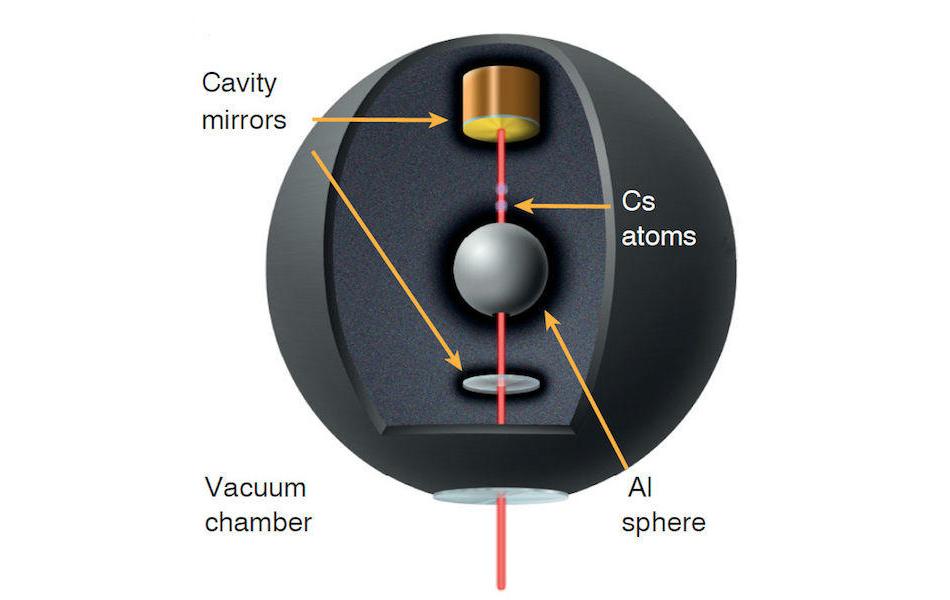Jul 28 2017
A collaboration between University of Pennsylvania and University of California, Berkeley, that is exploring a class of dark energy theories, called chameleon theories, has been awarded $1 million from the W.M. Keck Foundation.
 If chameleons exist, cesium atoms would fall toward the sphere with a slightly greater acceleration than gravity predicts. (Credit: University of Pennsylvania)
If chameleons exist, cesium atoms would fall toward the sphere with a slightly greater acceleration than gravity predicts. (Credit: University of Pennsylvania)
Justin Khoury, a professor in the Department of Physics & Astronomy in the School of Arts & Sciences at Penn, initially developed the project in 2004, while a postdoc at Columbia University.
Dark energy was first discovered in 1998 when scientists observed that the universe was expanding at an ever-increasing rate, apparently pushed apart by an unseen pressure permeating all of space and making up about 68 percent of the energy in the cosmos.
“Dark energy is one of the most pressing puzzles in physics,” Khoury said. “It makes up most of the universe, so we really ought to understand what's going on. Most likely, an understanding of dark energy is going to tell us something profound about physics and science more generally.”
There are many proposals about the nature of dark energy. The simplest one, Khoury said, is that dark energy is just the energy of the vacuum of space, which would have no laboratory or solar system implications. This vacuum energy would be constant in space and time, doing nothing other than influencing the expansion of the universe.
“If that's how dark energy is, then we have no chance of detecting it locally,” Khoury said.
What distinguishes theories like the chameleon is that they actually make predictions for experiments on Earth. In these theories, dark energy is viewed as dynamic: it evolves in time and varies in space.
“Chameleons are basically a form of dark energy whereby the agent that gives rise to dark energy can change its properties depending on the environment,” Khoury said. “In particular it uses the large density of the local environment to hide itself from experiments. If you have large objects such as Earth or the sun, the effects of the chameleon will be efficiently hidden. But if you take a small particle, such as an atom, it can have a relatively substantial effect.”
At Berkeley, researchers involved in the collaboration, led by Holger Müller, an associate professor of physics and the principle investigator of the project, use a technique called atom interferometry to investigate these ideas. Atom interferometry harnesses a fundamental principle of quantum mechanics called superposition, which states that particles can be in two places at the same time.
The researchers start with a source sphere in a vacuum chamber. They release a cloud of atoms, which they can control with lasers. They first split the atoms’ wave functions so that they go through two different paths at once, and then they recombine the atoms, measuring the force between the source mass and the atoms. The entire experiment, Khoury said, fits on a tabletop.
“The motion of these atoms are governed by gravity,” he said. “But if there were a chameleon force, then that would also influence their motion. By using atom interferometry, they can actually tell whether or not there's a chameleon force on top of gravity. It's a really powerful, extremely precise experiment. It’s also cutting-edge. This field of atom interferometry is relatively new, and it's a very hot field, and so this collaboration is bringing Berkeley’s expertise to try to constrain or potentially discover this theory of dark energy.”
The W. M. Keck Foundation Science and Engineering Grant will support both the experimental work at Berkeley and the theoretical work done at Penn. Atom interferometry rarely interplays with cosmology, Khoury said, but it is a burgeoning area or research that he hopes will become mainstream somewhere down the road. The grant will allow the collaboration to push things forward in a big way.
“What's very cool to me,” Khoury said, “is that we're using tabletop experiments, which normally you'd think would have no direct implication for how we understand dark energy and the expansion of the universe because that’s something that's happening on much larger scales. When I first came up with chameleons, I never dreamed that somebody one day would be using this cutting-edge experiment in a laboratory to either constrain or perhaps rule out this kind of idea.”